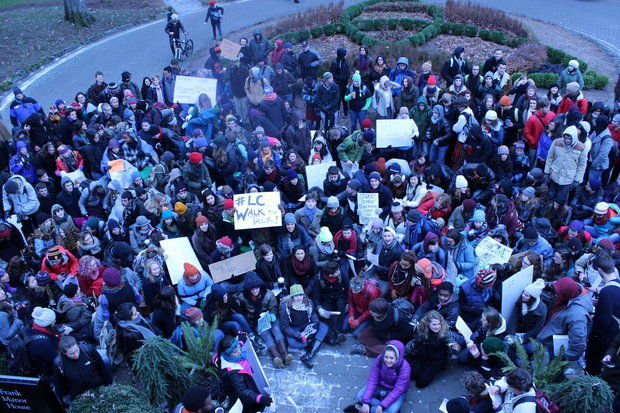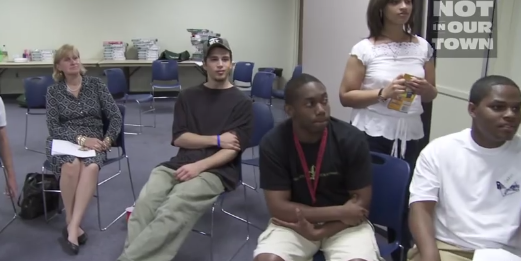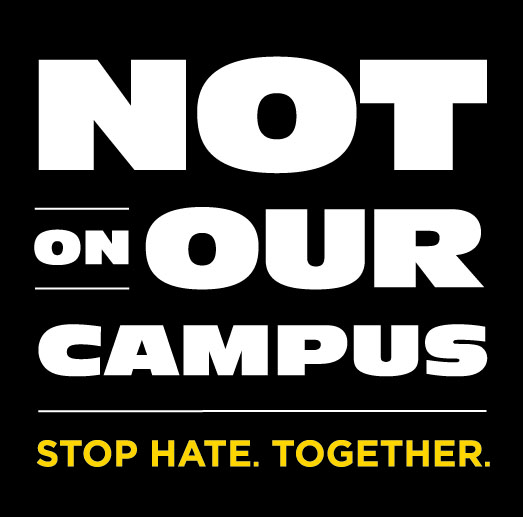
Student sit-in at Lewis & Clark College, Amy Rosenheim
By Karissa Tom
Last fall, racist slurs targeting black students at my school rocked my school community. Though black students make up a small minority of the school’s demographic, the hate-filled graffiti and the overheard jokes about “white power” left the whole student body feeling scared and threatened.
The initial reaction was shock and disbelief. At my seemingly accepting school in a politically liberal state, most people who heard about the incidents responded with, “This could never happen here!” Yet the sad truth remains that it did happen and that, when it did, my college as an institution and a community was unprepared for the consequences.
These incidents, while disheartening, provided an opportunity for the entire community to reflect on our school policy, our campus culture, and what can be done to prevent such incidents from occurring again. More than 200 students, joined by faculty, staff, alumni, and other community members joined together for a student-initiated sit-in outside the President of the College’s office.
Yet what is to be done after the sit-in? After campus cleared out for winter, and then summer break? What can be done after the initial reaction and the rally cries? As students, it may seem like creating a more accepting campus climate is out of reach. However, with the right tools, students can be the best advocates and agents for change in college.
Creating Alliances On Campus
Allyship is the process of building relationships, acknowledging privileges, and working with people of different identities to combat discrimination and intolerance, regardless of if you are on the targeted end of it or not. People who take action on behalf of others are called upstanders (in opposition to the more commonly used ‘bystander’). By promoting allyship on your campus through student advocacy and interdepartmental collaboration, you can create a community of upstanders on your campus.
Ask yourself what you can do to be an advocate for all members of your campus community. What ideals and missions does your community strive for, and are they truly reflected in your campus culture? Do students treat each other with respect? Does bullying, hazing, or discrimination occur on your campus? Do you or your friends know where to go to discuss these issues? If not, what can you do to make that information accessible to other students? And most importantly, how can you prevent more acts of intolerance on campus from happening again?

Students across the nation have stood up for safety and inclusion on their campuses by creating Not On Our Campus campaigns.
The Not On Our Campus Quick Start Guide is a useful tool that provides a step-by-step plan for creating a sustainable movement that empowers students to stand against discrimination, intolerance, and bullying on college campuses. It emphasizes the importance of having the entire campus united in creating a safe and welcoming campus.
Develop connections across your campus by with academic departments, student organizations, administrators, faculty, staff, and alumni. Whether it’s creating a coalition of black and white students to bridge racial and social barriers on campus, or enacting a new policy concerning discrimination, progress is made when all different groups and individuals on campus work together.
Sustainable Change for a Safe Campus
There’s an old saying that goes, “Those who don’t learn from history are doomed to repeat it.” When hate-motivated acts, bullying, or hazing occurs on your campus, it’s all too easy to sweep it aside as an isolated incident. Yet by addressing the underlying issues and by cultivating allyship and understanding, you are working to prevent such incidents from happening again.
 Being an upstander doesn’t require a big event every time you want to address bullying or intolerance on campus. College offers the unique experience that combines living and learning, so it’s important to incorporate allyship into many different aspects of campus life. For example, the University of California, Santa Barbara has a Not In Our Hall guide for resident advisors and directors that promotes inclusivity in residence halls.
Being an upstander doesn’t require a big event every time you want to address bullying or intolerance on campus. College offers the unique experience that combines living and learning, so it’s important to incorporate allyship into many different aspects of campus life. For example, the University of California, Santa Barbara has a Not In Our Hall guide for resident advisors and directors that promotes inclusivity in residence halls.
Encouraging collaboration between student organizations such as cultural clubs, LGBTQQ organizations, and fraternities and sororities builds empathy and understanding. For a sustained movement for inclusion and safety, take part in peer mentoring programs that give younger students guidance on how to continue your anti-hate efforts.
College campuses should be safe spaces for students to learn and grow. When you work to increase acceptance and diversity on campus, the entire college community benefits. Since the sit-in at my school, students have been working to create more inclusionary policies, but they are still struggling with their implementation. As we prepare to return in the fall, I’m hopeful that the student body’s belief in a better campus free of intolerance will soon become a reality.
Karissa Tom is the summer social media intern at Not In Our School and studies Sociology and Anthropology at Lewis & Clark College.
Add new comment